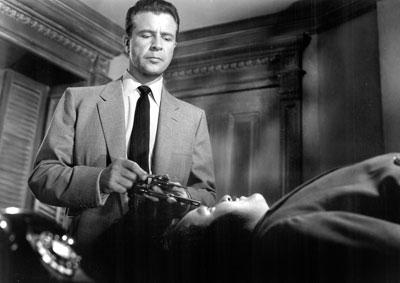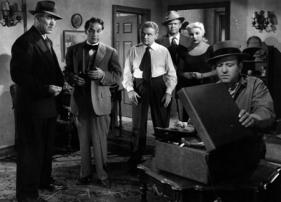Directed by Robert Parrish
Olympic Productions, Inc./A Wiesenthal-Frank Production/RKO Radio Pictures, Inc. Producer: Sam Wiesenthal. Screenwriter: William Bowers, from a story by Jerome Cady. Cinematographer: Joseph F. Biroc. Editor: Bernard W. Burton. With: Dick Powell, Rhonda Fleming, Richard Erdman, William Conrad, Regis Toomey. 35mm, b/w, 79 min.
In his directorial debut, former editor Robert Parrish skillfully illuminates screenwriter Bill Bowers’ equally acerbic and droll Cry Danger into an underappreciated noir gem.
Even though this Jerome Cady story was originally purchased by Humphrey Bogart’s Santana Pictures, the film ended up being the only release by Olympic Productions. The tersely pitch-perfect Dick Powell portrays protagonist ex-convict Rocky Mulloy who returns to Los Angeles to find the gang that framed him for a crime he did not commit. Aided by a hard-drinking, crippled ex-marine (brilliantly realized by Richard Erdman), Mulloy sets up home-base at a Bunker Hill trailer camp that is home to his ex-girlfriend Nancy, played by the graceful Rhonda Fleming. Fleming, who was on loan from David O. Selznick’s company for this project, underwent an emergency appendectomy that initially held up the film’s very tight twenty-two day shooting schedule.
Dick Powell had already transitioned comfortably to crime dramas with the likes of Murder, My Sweet and Pitfall to name a few. The stand out performance here belongs to his cohort Erdman. The New York Times noted that the film had “sardonic lines that are tossed off most effectively by a young actor named Richard Erdman, who has been around Hollywood since 1943—just waiting for the right chance, no doubt. Cry Danger gives it to Mr. Erdman and he makes the most of it…” Jean Porter, wife of frequent noir director Edward Dmytryk, is also a standout delight as one of the several downtown Los Angeles denizens adding the equally amusing and seedy local color.
The film premiered and opened in San Francisco with Fleming scheduled to attend; unfortunately the actress’ father died and it wasn’t until years later that she finally saw the film and now considers it one of her favorites. Preservation partner and Film Noir Foundation President Eddie Muller calls it a “crackerjack crime film—short, smart, sassy, and full of surprises.”
Todd Wiener
Preserved in cooperation with Paramount Pictures and Warner Bros. from two 35mm acetate composite master positives. Laboratory services by The Stanford Theatre Film Laboratory, Audio Mechanics, DJ Audio, Film Technology Company, Inc. Special thanks to: Hal Jones, Eddie Muller, Ned Price.






 Mobile Navigation
Mobile Navigation


